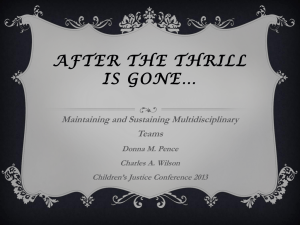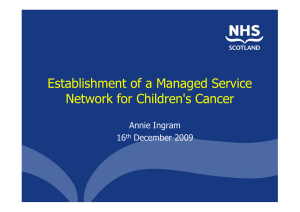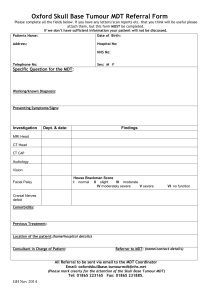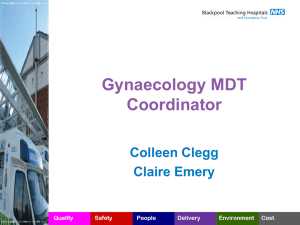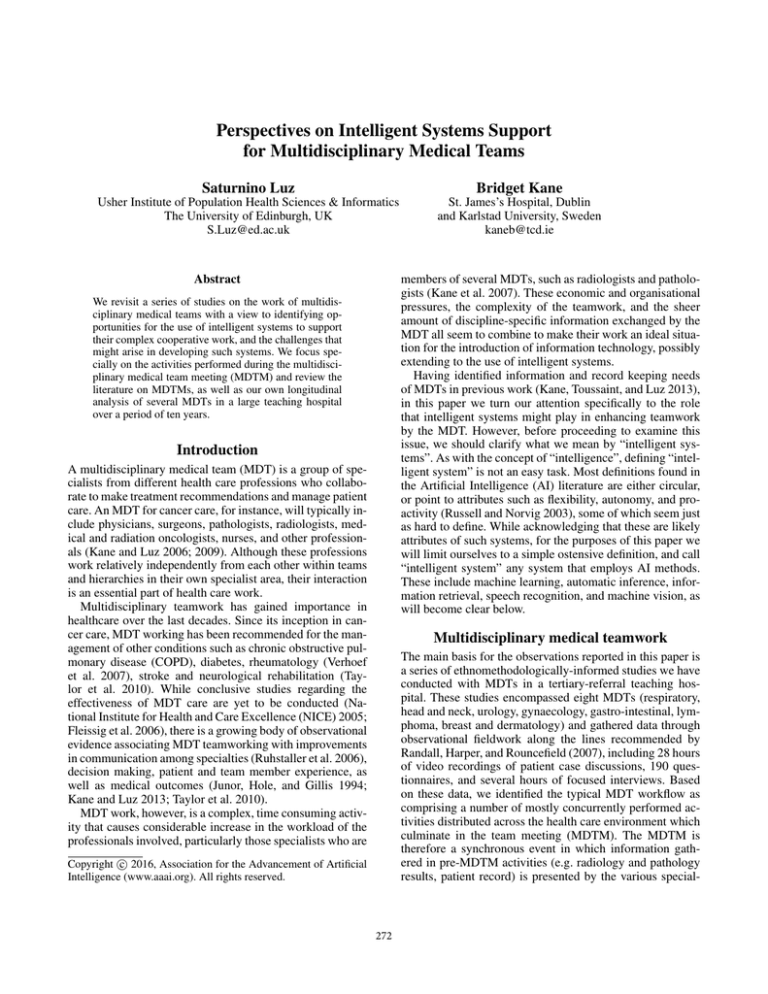
Perspectives on Intelligent Systems Support
for Multidisciplinary Medical Teams
Saturnino Luz
Bridget Kane
Usher Institute of Population Health Sciences & Informatics
The University of Edinburgh, UK
S.Luz@ed.ac.uk
St. James’s Hospital, Dublin
and Karlstad University, Sweden
kaneb@tcd.ie
members of several MDTs, such as radiologists and pathologists (Kane et al. 2007). These economic and organisational
pressures, the complexity of the teamwork, and the sheer
amount of discipline-specific information exchanged by the
MDT all seem to combine to make their work an ideal situation for the introduction of information technology, possibly
extending to the use of intelligent systems.
Having identified information and record keeping needs
of MDTs in previous work (Kane, Toussaint, and Luz 2013),
in this paper we turn our attention specifically to the role
that intelligent systems might play in enhancing teamwork
by the MDT. However, before proceeding to examine this
issue, we should clarify what we mean by “intelligent systems”. As with the concept of “intelligence”, defining “intelligent system” is not an easy task. Most definitions found in
the Artificial Intelligence (AI) literature are either circular,
or point to attributes such as flexibility, autonomy, and proactivity (Russell and Norvig 2003), some of which seem just
as hard to define. While acknowledging that these are likely
attributes of such systems, for the purposes of this paper we
will limit ourselves to a simple ostensive definition, and call
“intelligent system” any system that employs AI methods.
These include machine learning, automatic inference, information retrieval, speech recognition, and machine vision, as
will become clear below.
Abstract
We revisit a series of studies on the work of multidisciplinary medical teams with a view to identifying opportunities for the use of intelligent systems to support
their complex cooperative work, and the challenges that
might arise in developing such systems. We focus specially on the activities performed during the multidisciplinary medical team meeting (MDTM) and review the
literature on MDTMs, as well as our own longitudinal
analysis of several MDTs in a large teaching hospital
over a period of ten years.
Introduction
A multidisciplinary medical team (MDT) is a group of specialists from different health care professions who collaborate to make treatment recommendations and manage patient
care. An MDT for cancer care, for instance, will typically include physicians, surgeons, pathologists, radiologists, medical and radiation oncologists, nurses, and other professionals (Kane and Luz 2006; 2009). Although these professions
work relatively independently from each other within teams
and hierarchies in their own specialist area, their interaction
is an essential part of health care work.
Multidisciplinary teamwork has gained importance in
healthcare over the last decades. Since its inception in cancer care, MDT working has been recommended for the management of other conditions such as chronic obstructive pulmonary disease (COPD), diabetes, rheumatology (Verhoef
et al. 2007), stroke and neurological rehabilitation (Taylor et al. 2010). While conclusive studies regarding the
effectiveness of MDT care are yet to be conducted (National Institute for Health and Care Excellence (NICE) 2005;
Fleissig et al. 2006), there is a growing body of observational
evidence associating MDT teamworking with improvements
in communication among specialties (Ruhstaller et al. 2006),
decision making, patient and team member experience, as
well as medical outcomes (Junor, Hole, and Gillis 1994;
Kane and Luz 2013; Taylor et al. 2010).
MDT work, however, is a complex, time consuming activity that causes considerable increase in the workload of the
professionals involved, particularly those specialists who are
Multidisciplinary medical teamwork
The main basis for the observations reported in this paper is
a series of ethnomethodologically-informed studies we have
conducted with MDTs in a tertiary-referral teaching hospital. These studies encompassed eight MDTs (respiratory,
head and neck, urology, gynaecology, gastro-intestinal, lymphoma, breast and dermatology) and gathered data through
observational fieldwork along the lines recommended by
Randall, Harper, and Rouncefield (2007), including 28 hours
of video recordings of patient case discussions, 190 questionnaires, and several hours of focused interviews. Based
on these data, we identified the typical MDT workflow as
comprising a number of mostly concurrently performed activities distributed across the health care environment which
culminate in the team meeting (MDTM). The MDTM is
therefore a synchronous event in which information gathered in pre-MDTM activities (e.g. radiology and pathology
results, patient record) is presented by the various special-
c 2016, Association for the Advancement of Artificial
Copyright Intelligence (www.aaai.org). All rights reserved.
272
ists, and from which a number of post-MDTM tasks (e.g. implementation of patient management decisions, updating of
various databases, and further tests or scans) originate (Kane
and Luz 2006). For this reasons, we focus our analysis on the
MDTM and the informational requirements it entails.
The MDTM is a weekly meeting normally lasting approximately 105 minutes. It takes place in a room configured in a theatre-style arrangement, with large screens in
front which are used to display radiological images, pathology images, and occasionally video images of participants
who join in from remote hospitals through videoconferencing. The MDTM is attended by physicians, surgeons, radiologists, pathologists, radiation and medical oncologists,
nurses, a data manager and administrator, and often other
paramedical specialists (such as a physiotherapist, a dietitian, or a speech and language therapist) depending on the
nature of the MDT. Medical and surgical staff in-training are
also part of the multidisciplinary team and attend MDTMs.
Specialists bring information to the MDTM and pool it
into the discussion. Some specialities may use visual aids
to describe findings. This is the case of radiologists who
contribute in the diagnosis. Others bring expertise and contribute more to the discussion of the management decision,
such as oncologists. The MDTM is structured as a sequence
of patient case discussions (PCDs). In the initial stage of
the PCD, the clinical findings (signs and symptoms) are
reviewed in conjunction with the radiology and pathology
findings. The PCD is usually opened by the clinician who
examined the patient, who summarises the symptoms and
clinical findings. Endoscopic or surgical findings may be reported. A radiologist will typically continue the discussion
by illustrating relevant features in any images undertaken,
such as chest radiographs, CT, PET and MRI1 scans, followed by the pathologist who demonstrates the microscopic
tissue structures in the biopsy samples, or surgical specimens (Kane and Luz 2009).
The definitive diagnosis and disease stage is agreed by the
MDT, following presentation and correlation of the clinical,
radiology and pathology findings, in a process of consensus
(Kane and Luz 2009). This correlation of findings is unique
to MDTMs in the patient care pathway, improving patient
safety by allowing revision of results, resolution of inconsistencies, and identification of unsatisfactory work practices.
The MDTM serves a number of functions within the
healthcare organisation. Its primary purpose is patient management. This primary function facilitates certain organisational goals such as collection of information for audit purposes, and provision a feedback mechanism for participants
in their individual roles. In addition, the meetings are supposed to serve medical education purposes, contribute to the
professional development of medical and other staff, and potentially contribute data for research databases, such as cancer registries.
The information requirements of the MDT during the
MDTM are detailed by Kane, Toussaint, and Luz (2013).
The group interacts and exchanges information mainly
through talk, so auxiliary information (e.g. patient records,
medical images) need to be comprehensive and quickly accessible. Some of the information generated at the meeting
should later go into the patient’s chart, and records must be
kept of task assignments and their execution post MDTM.
As noted above, some of this information, and the discussion
process itself, could provide valuable resources for training and research, as well as registries and official statistics
organisations. These requirements encompass many interdependencies, making it unlikely that conventional information systems would be flexible enough to anticipate all possible branching points and exceptions to an idealised workflow (Ash, Berg, and Coiera 2004; Collins 1992).
Intelligent support for MDT work
The demanding nature of the tasks facing the MDT and the
complexity of the information and recording requirements of
the MDTM suggest that their needs cannot be easily met by
conventional information systems. In the following sections
we explore the possibilities for the use of intelligent systems
in this setting. We focus on requirements for information
records relating to the patient management, organisational,
research and educational roles of the MDTM, drawing on
the findings of Kane, Toussaint, and Luz (2013).
Opportunities
Regarding background data collected prior to the MDTM
and presented at the meeting, possibly the most obvious opportunity for introduction of intelligent systems is in support for finding and accessing relevant information. Textual
Information retrieval technology has now reached a level of
maturity that allows it to be used reliably in a variety of settings. Its use in connection with electronic health records
(EHR) is relatively straightforward. Furthermore, even in
situations where the MDT uses different systems that may
lack standardisation and interoperability, a level of intelligence and automation can be implemented which would
make the task of gathering information considerably more
efficient. Presentation of scientific evidence gathered from
the research literature is a common practice in MDTM work
(Frykholm and Groth 2011). Systems that can seamlessly
unify access to heterogeneous data sources, such as the
EHR, national and international registries, and medical literature databases, might enhance the educational and professional development roles of the MDTM as well as enable
its participants to further enrich the case discussions.
Similarly, while text categorisation and information extraction methods applied to loosely structured or free-form
textual data are less mature than information retrieval technology, they can also be employed in support of MDT work,
possibly in conjunction with well developed medical ontologies to guide the text mining system. In our analysis of the
need for an information record for shared decision making
at MDTMs (Kane, Toussaint, and Luz 2013), we found that,
despite growing standardisation, free textual information is
likely to continue to play an important role in documentation. When a the group adopted a structured form, consisting
of multiple tabs, tables and check-boxes, aimed at capturing
1
Short for Computed Tomography, Positron Emmission Tomography, Magnetic Resonance Imaging, respectively.
273
essential items of information exchanged during the MDTM
for incorporation into the EHR, the person in charge of entering the data eventually abandoned the form structure and
entered free form text instead. This was due in part to the
time constraints under which the MDT operates, but more
broadly it reflects a suspicion that this could well turn into
one of those processes that Ash, Berg, and Coiera (2004)
describe as “causing cognitive overload by overemphasizing
structured and ‘complete’ information entry or retrieval.”
Beyond text, retrieval of images based on similarity of regions of interest also presents potential opportunities. Automatic image matching techniques can be employed to retrieve similar radiology images based on the patient’s scan.
They can be combined with text mining of, say, radiology
reports, to assist in the assessment of cases. Napel et al.
(2010), for instance, presented an intelligent system which
can accurately retrieve CT Images based on visual similarity. Integrating such systems with MDTM work may also
improve the training role of the MDTM, by providing context for post-MDTM review and study.
It is widely acknowledged that the information exchanged
through talk during the MDTM is a potentially valuable resource. A comprehensive record of the meeting might be
used, for instance, to provide the contextual information necessary for the interpretation of decisiosn recorded in the formal report produced at the MDTM. These reports are necessarily concise. One such report might read “36yrs. Core Rt
breast FA 2.5cms. Path FA B2. Concordant. Reassure & DC”
(Kane, Toussaint, and Luz 2013). Reviewing a recording or
transcription of the PCD would enable an MDT member to
understand the rationale and the diagnosis process that led to
this formal report. Accessing recorded unstructured meeting
interaction data has been the focus of much work in the field
of meeting browsing. Systems have been proposed, for instance, that support the production of an index to facilitate
access to relevant time-based content by exploiting the natural structuring points of meeting interaction, such as synchronous writing events (Bouamrane et al. 2004).
In the absence of dedicated infrastructure to capture such
events, however, access to time-based recordings need to
rely on more complex (and error prone) methods such as diarisation (i.e. the automatic determination of who spoke and
when), automatic speech recognition (ASR), topic segmentation, and automatic summarisation. Although the use of
these methods for meeting browsing in general has yielded
mixed results, the relatively better structured nature of the
MDTM as a sequence of PCDs makes it possible to automatically identify relevant metadata. Good accuracy can be
achieved in tasks such as automatically locating PCDs in
MDTM recordings (Luz 2009) and segmenting these recordings into PCDs and discussion stages (or topics) within
PCDs (Luz 2012), even under adverse recording conditions. In addition, once recording segments corresponding
to PCDs have been identified and represented as vocalisation graphs, categorisation of PCDs can also be performed
quite reliably (Luz and Kane 2009).
In addition to providing context for patient management
decisions (e.g. by answering queries such as “Did X say anything about the possibility of Y option?”) , and potentially
contributing to audit tasks, a fully indexed recording of the
actual MDTM produced along these lines, may also serve as
an educational resource. It has been reported that the role of
the MDTM in medical education used to be quite prominent,
with the MDT discussing a small number of ‘interesting
cases’. As MDTMs became embedded in routine work of the
hospital, their educational roles diminished. Another consequence of this development, and of the workflow increase it
caused, is that it has become more difficult for participants
outside the core MDT to assimilate information presented
at the meetings (Kane and Luz 2013). Automation could be
used to identify among the indexed PCDs those that might
be considered ‘interesting’ from an educational perspective,
and recordings of such PCDs could be made available for
review by students and junior staff, under more favourable
conditions than the busy settings of a live MDTM.
As regards support for documentation tasks performed
during the MDTM, information extraction techniques might
be useful for converting free text documentation into records
amenable to integration with the hospital’s EHR system. If
accurate transcripts can be generated by ASR, then tracking task assignment for post-MDTM monitoring may also
be possible. This would meet a need often stated by MDT
members (Kane, Toussaint, and Luz 2013).
Challenges
While there are many potential opportunities for the use of
intelligent systems to support MDT work, significant challenges must be overcome for the potential of such systems
to be realised in this setting. Some of these challenges are
technical, but the most important ones are likely to be sociotechnical or organisational.
From a technical perspective, the difficulties are mostly
related with the unconventional ways the information gets
recorded in textual form, with the problem of rendering
speech content into accurate textual summaries, and with the
need for complex semantic processing in order to turn even
a fully accurate transcript into meaningful data items.
As mentioned, the recording of the meeting’s decisions
and relevant follow-up actions is typically done in free text
and in codified form due to time pressures and work load.
This results in text that cannot be straightforwardly linked
to external information by automatic indexing systems, and
that might not have clear meaning in the absence of relevant
contextual information.
Contextual information could perhaps be provided
through processing of the speech data that forms part of the
discussion, possibly off-line, after the MDTM. However, implementing the kind of processing required is far from being
a solved problem. Answering the seemingly simple question “Did X say anything about the possibility of Y option?”
would require, minimally, the existence of a robust diarisation system. Diarisation is still very much a researched topic.
Diarisation error rates of 20% are not uncommon in realistic
settings. This level of performance may prove unacceptable
in a safety-critical setting such as the MDTM. In addition,
even in tasks where error may be acceptable, such as identification of PCDs for training and professional development
purposes, poor diarisation might lead to poor segmentation
274
and classification performance. In PCD segmentation, for instance, a 20% diarisation error will typically lead to a 15%
increase in segmentation error in comparison to a perfectly
diarised recording (Luz 2012).
ASR tends to perform poorly in noisy environments. The
MDTMs we studied take place in a poor acoustic environment, to the extent that peripheral participants have difficulties in understanding what is being said in the discussions.
Unsatisfactory ASR performance is therefore to be expected.
However, even if the transcripts were perfect, sophisticated
semantic processing well beyond the capabilities of current
systems may be necessary. Consider, for instance, the difficulty of linking the semantics of the recorded note mentioned earlier (36yrs. Core Rt breast FA 2.5cms. Path FA B2.
Concordant. Reassure & DC) with the verbal discussion that
resulted in it: ‘So, we are concordant then, that it is fibroadenoma - radiology and pathology agree. Is that right?’
Further to these substantial technical challenges, sociotechnical factors might have a decisive bearing on
whether intelligent systems will eventually be adopted or
not. Many of the methods proposed above require at least
audio recording of the MDTM. MDT members, however,
are reluctant to allow recording due to privacy concerns, as
well as concerns might stifle the discussion. Although anonimisation and other methods could mitigate some of these issues while still enabling crucial information to be extracted
from the live discussion, resistance to systems that involve
recording is likely to remain a serious challenge.
Kane, B., and Luz, S. 2006. Multidisciplinary medical team
meetings: An analysis of collaborative working with special
attention to timing and teleconferencing. Computer Supported Cooperative Work 15(5):501–535.
Kane, B., and Luz, S. 2009. Achieving diagnosis by consensus. Computer Supported Cooperative Work 18(4):357–391.
Kane, B., and Luz, S. 2013. “Do no harm”: Fortifying MDT
collaboration in changing technological times. International
Journal of Medical Informatics 82(7):613–625.
Kane, B.; Luz, S.; O’Briain, D. S.; and McDermott, R.
2007. Multidisciplinary team meetings and their impact on
work-flow in radiology and pathology departments. BMC
Medicine 5(15).
Kane, B. T.; Toussaint, P. J.; and Luz, S. 2013. Shared decision making needs a communication record. In Proceedings
of the 2013 conference on Computer supported cooperative
work, CSCW ’13, 79–90. New York, NY, USA: ACM.
Luz, S., and Kane, B. 2009. Classification of patient case
discussions through analysis of vocalisation graphs. In Proceedings of the 11th International Conference on Multimodal Interfaces and Machine Learning for Multimodal Interaction (ICMI’09), 107–114. Cambridge, MA: ACM.
Luz, S. 2009. Locating case discussion segments in recorded
medical team meetings. In Proceedings of the ACM Multimedia Workshop on Searching Spontaneous Conversational
Speech (SSCS’09), 21–30. Beijing, China: ACM Press.
Luz, S. 2012. The non-verbal structure of patient case discussions in multidisciplinary medical team meetings. ACM
Transactions on Information Systems 30(3):17:1–17:24.
Napel, S. A.; Beaulieu, C. F.; Rodriguez, C.; Cui, J.; Xu,
J.; Gupta, A.; Korenblum, D.; Greenspan, H.; Ma, Y.; and
Rubin, D. L. 2010. Automated Retrieval of CT Images of
Liver Lesions on the Basis of Image Similarity: Method and
Preliminary Results. Radiology 256(1):243–252.
National Institute for Health and Care Excellence (NICE).
2005. Diagnosis and treatment of lung cancer. methods, evidence and guidance. London.
Randall, D.; Harper, R.; and Rouncefield, M. 2007. Fieldwork for design: theory and practice. Springer-Verlag.
Ruhstaller, T.; Roe, H.; Thürlimann, B.; and Nicholl, J. J.
2006. The multidisciplinary meeting: An indispensable aid
to communication between different specialities. European
Journal of Cancer 42:2459–2462.
Russell, S. J., and Norvig, P. 2003. Artificial Intelligence. A
Modern Approach. Englewood Cliffs: Prentice-Hall.
Taylor, C.; Munro, A.; Glynne-Jones, R.; Griffith, C.; Trevatt, P.; Richards, M.; and Ramirez, A. 2010. Multidisciplinary team working in cancer: what is the evidence? BMJ
340:c951.
Verhoef, J.; Toussaint, P. J.; Putter, H.; Zwetsloot-Schonk,
J. H. M.; and Vlieland, T. P. M. V. 2007. The impact of
the implementation of a rehabilitation tool on the contents
of the communication during multidisciplinary team conferences in rheumatology. International Journal of Medical
Informatics 76(11–12):856–863.
Conclusion
There is a great potential for AI technologies to have positive impacts on MDT teamwork. However, their use pose a
number of challenges. Careful analysis of human factors affecting medical teamwork in combination with judicious use
of AI methods are necessary for this potential to be realised.
References
Ash, J.; Berg, M.; and Coiera, E. 2004. Some unintended consequences of information technology in health
care: the nature of patient care information system-related
errors. JAMIA 11(2):104–112.
Bouamrane, M.-M.; King, D.; Luz, S.; and Masoodian, M.
2004. A framework for collaborative writing with recording and post-meeting retrieval capabilities. IEEE Distributed
Systems Online.
Collins, H. M. 1992. Artificial Experts: Social Knowledge
and Intelligent Machines. Cambridge: MIT Press.
Fleissig, A.; Jenkins, V.; Catt, S.; and Fallowfield, L. 2006.
Multidisciplinary teams in cancer care: are they effective in
the UK? The Lancet Oncology 7(11):935–943.
Frykholm, O., and Groth, K. 2011. References to personal
experiences and scientific evidence during medical multidisciplinary team meetings. Behaviour & Information Technology 30(4):455–466.
Junor, E. J.; Hole, D. J.; and Gillis, C. R. 1994. Management of ovarian cancer: referral to a multidisciplinary team
matters. British Journal of Cancer 70(2):363–370.
275

